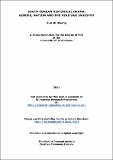Files in this item
South Korean historical drama : gender, nation and the heritage industry
Item metadata
| dc.contributor.advisor | Martin-Jones, David | |
| dc.contributor.advisor | Vidal, Belén | |
| dc.contributor.author | Hwang, Yun Mi | |
| dc.coverage.spatial | 360 | en_US |
| dc.date.accessioned | 2011-07-20T15:20:13Z | |
| dc.date.available | 2011-07-20T15:20:13Z | |
| dc.date.issued | 2011-06-24 | |
| dc.identifier.uri | https://hdl.handle.net/10023/1924 | |
| dc.description | Electronic version excludes material for which permission has not been granted by the rights holder | en_US |
| dc.description.abstract | From the dynamic landscape of contemporary South Korean cinema, one trend that stands out is the palpable revival of the historical drama (known as the ‘sageuk’ in Korean). Since the early 2000s, expensive, visually striking, and successful costumed pieces have been showcased to the audience. Now rivalling the other mainstream genres such as gangster action, romantic comedy, and the Korean blockbuster, the sageuk has made an indelible impact on the national film industry. Even so, the cycle has yet to receive much critical attention. This thesis addresses the gap, driven by the question, what is the impetus behind the surge of the ‘historical’ witnessed in recent sageuk films? For this, I first take a diachronic view of the historical context of the genre, which later serves as the reference point for the genre memory. Adopting a synchronic approach, I then examine the industrial, political, and social contexts in Korea at the turn of the new century that facilitated the history boom. While national memory and transnational politics fuelled Koreans’ interest in their past, the popular media – cinema, television, publishing industry, and performance theatre – all capitalised on this drive. The government also took part by supporting the ‘culture content industry’ as a way to fashion an attractive national image and accelerate the cultural export system. Collectively, these efforts translated to the emergence of history as a commodity, carving a unique space for historical narratives in the national heritage industry. As such, different agents – the consumers, the industry, and the state – had their stakes in the national mobilisation of history and memory with competing ideological and commercial interests. Ultimately, the sageuk is the primary site in which these diverging aspirations and desires are played out. In chapters that follow, I engage with four main sub-types of the recent historical drama, offering textual and contextual readings. The main discussion includes the ‘fusion’ sageuk (Untold Scandal), the biopic (King and the Clown and Portrait of a Beauty), the heritage horror (Blood Rain and Shadows in the Palace), and the colonial period drama (Rikidozan, Blue Swallow and Modern Boy). While analysing the generic tropes and narrative themes of each film, I also pay attention to contemporary discourses of gender, and the cultural treatment of masculinity and femininity within the period setting. Such investigation, in turn, locates the place of the historical genre in New Korean Cinema, and thus, offers a much-needed intervention into one of the neglected topics in the study of cinematic trends in South Korea. | en_US |
| dc.language.iso | en | en_US |
| dc.publisher | University of St Andrews | |
| dc.rights | Creative Commons Attribution-NonCommercial-NoDerivs 3.0 Unported | |
| dc.rights.uri | http://creativecommons.org/licenses/by-nc-nd/3.0/ | |
| dc.subject | Biopic | en_US |
| dc.subject | Period horror | en_US |
| dc.subject | Historical dramas | en_US |
| dc.subject | Heritage industry | en_US |
| dc.subject | New Korean Cinema | en_US |
| dc.subject | Gender | en_US |
| dc.subject | National cinema | en_US |
| dc.subject | Genre | en_US |
| dc.subject.lcc | PN1993.5K7H8 | |
| dc.subject.lcsh | Historical films--Korea (South)--History and criticism | en_US |
| dc.subject.lcsh | Cultural property--Korea (South) | en_US |
| dc.subject.lcsh | Motion pictures--Korea (South)--History | en_US |
| dc.subject.lcsh | Gender identity in motion pictures | en_US |
| dc.title | South Korean historical drama : gender, nation and the heritage industry | en_US |
| dc.type | Thesis | en_US |
| dc.type.qualificationlevel | Doctoral | en_US |
| dc.type.qualificationname | PhD Doctor of Philosophy | en_US |
| dc.publisher.institution | The University of St Andrews | en_US |
This item appears in the following Collection(s)
Except where otherwise noted within the work, this item's licence for re-use is described as Creative Commons Attribution-NonCommercial-NoDerivs 3.0 Unported
Items in the St Andrews Research Repository are protected by copyright, with all rights reserved, unless otherwise indicated.


